Go behind the scenes with the Emmy-nominated sound designers who created the Ghorman soundscape, one of Season 2’s most important locations complete with its own language and unique anthem.
Sound design is all about the focus. Who you’re with in a scene. The location. The actions. The emotions.
While Ghorman has been mentioned in previous Star Wars stories, including Andor’s first season and the Star Wars Rebels episode “Secret Cargo,” Andor Season 2 marks the world’s live-action debut. First seen (and heard) in Andor’s travelogue newsreel, series creator and executive producer Tony Gilroy led the creative team on the immersive building that would lead to a massacre in a city plaza, with composer Brandon Roberts and sound designers David Acord and Margit Pfeiffer joining forces to bring the sounds of the planet to the screen — culminating in the episode "Who Are You?" which has been recognized with a nomination for Outstanding Sound Editing and Outstanding Sound Mixing at the 2025 Emmy® Awards.
Ghorman is of great interest to the Empire…
We got our first glimpse of Ghorman in the Season 2 premiere “One Year Later,” when Director Orson Krennic played a short film about the planet’s textile manufacturing to a room full of ISB operatives. Roberts’ score for the short leaned into the idea of it as a tourism propaganda film and helped him establish the Ghor music with a “colorful, waltzy 3/4 Straussian feel.”
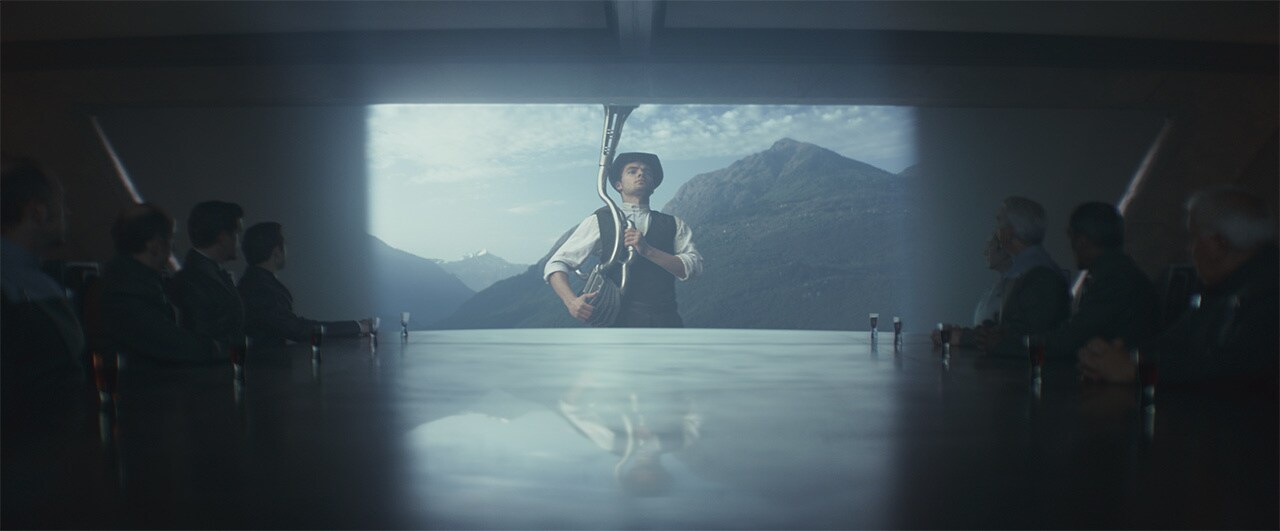
The travel video also introduced two instruments that can prominently be heard throughout most Ghorman scenes — the hammered dulcimer and the Hungarian cimbalom. These two unique string instruments were featured during the more lively parts of the score in Ghorman’s early appearances in Season 2 and can also be heard in the heist sequence and in Episode 8 “Who Are You?” leading up to the massacre where the sounds were pitched down two or three octaves for a darker version of the sound texture.
The music for the planet was also influenced by the vista shots of the main city and the nature around it which “dictated and communicated what the score might be and what the scenes could hold musically,” says Roberts. “Going back to the Ghorman tourism film, the big almost like Swiss alps vibe all hints to what could work musically and then the linchpin would up being the cimbalom player that added that extra bit of color – you can’t quite identify what is was so it didn’t feel too terrestrial or too grounded in a traditional waltz.”
Roberts shares credit for composing the series with Nicholas Britell, whose work is primarily heard in Season 1 as well as a handful of Season 2 episodes; Britell also co-wrote the Ghor anthem with Gilroy. “When you’re taking the reins from someone it’s incredibly beneficial to love their music,” notes Roberts, “and I’ve been a huge fan of Nicholas Britells’s music from even before he’d started on Andor. I was happy to try to do justice to it.”
Aiding Robert’s work in the series was his unique access to rough cuts of all 12 episodes from Andor’s second season, allowing him to watch the action before he began creating its score. “Normally TV schedules are so tight you’re writing music for episode one or two and they’re frantically editing the next few episodes,” says Roberts. “Even if you’ve read the scripts, it’s just not the same as seeing where it all goes from the editing to the pacing. It influences the music, obviously, so having that was huge upfront.”
“We Are the Ghor”
A large part of the sonic world of Ghorman came from the Ghor language — a fictional tongue created by Andor dialect coach Marina Tyndall. In addition to the language, Tony Gilroy and Nicholas Britell wrote the words and melody for the national anthem for the Ghor before filming began on Season 2. That patriotic piece would feature prominently in the lead up to the Ghorman massacre.
Early Ghorman scenes featuring Syril Karn and the Ghorman Front notably have lighter and more playful music before the story takes a much darker turn. “Speaking from a music front, it’s all that more jarring and hard to watch and listen to because the music has come from a place that was a little bit more fun,” Roberts says.
During the double heist sequence in Episode 6 “What a Festive Evening,” Kleya Marki removes a listening device from a Coruscant party as Vel Sartha and Cinta Kaz help members of the Ghorman Front steal an Imperial shipment of weapons on Ghorman. “We're trying to build tension by ramping up each of those pieces as you cut back and forth,” says David Acord. The pulsing party music subtly calls to mind a ticking clock (see above clip), a note from producer John Gilroy, who regularly sat in the mix with Acord. John had the idea, “to have the sound of the carts sliding down the ramp into the sewers sort of rhythmically happening through the sequences,” Acord says.
The mounting tension all leads to the Ghorman massacre in Episode 8, “Who Are You?” when we see the Empire incite a deadly riot in the Palmo plaza. The lead up to the slaughter and the genocide itself was a highly complex sequence that required multiple teams to work together to find the right balance of music, dialogue, and sound effects.
“Doom Bends”
Part of the emotional pull of the episode comes from musical moments Roberts described as “doom bends,” created from musicians playing basses and cellos. “You have the notes you want them to get to, but instead of them fingering the notes nicely, we’re having them slide from one to the other,” notes Roberts. “They give a kind of seasick feel. We wound up using microphones that were incredibly close which makes everything sound gritty and in your face. As the episode progresses we’re distorting everything a bit more to give this feeling subconsciously and musically of things going awry.”
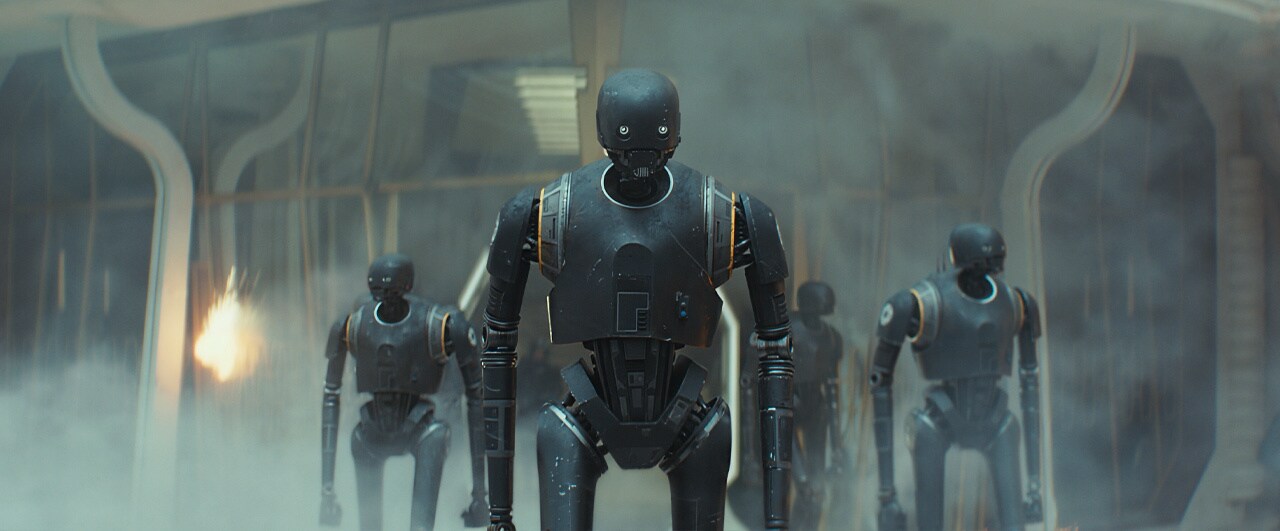
Above: The tension builds in Palmo Plaza in Episode 8, “Who Are You?”
For the massacre sequence in particular, Margit Pfeiffer emphasized the importance of building up to the climactic conflict. “You start low and you build in waves,” says Pfeiffer. “You cut back and forth and ramp up, otherwise it's just all a wash of sound.” Pfeiffer likened the audio design to a tapestry. “As you go through these scenes, you weave in out of the sound design elements, the weaponry, the explosions, the KX units coming onto the plaza, the yelling, the aggression, and towards the end, it builds the desperation. You'll feature the person or the weaponry, the gunshots, and then you want to hand off to the music a little bit to carry it.”
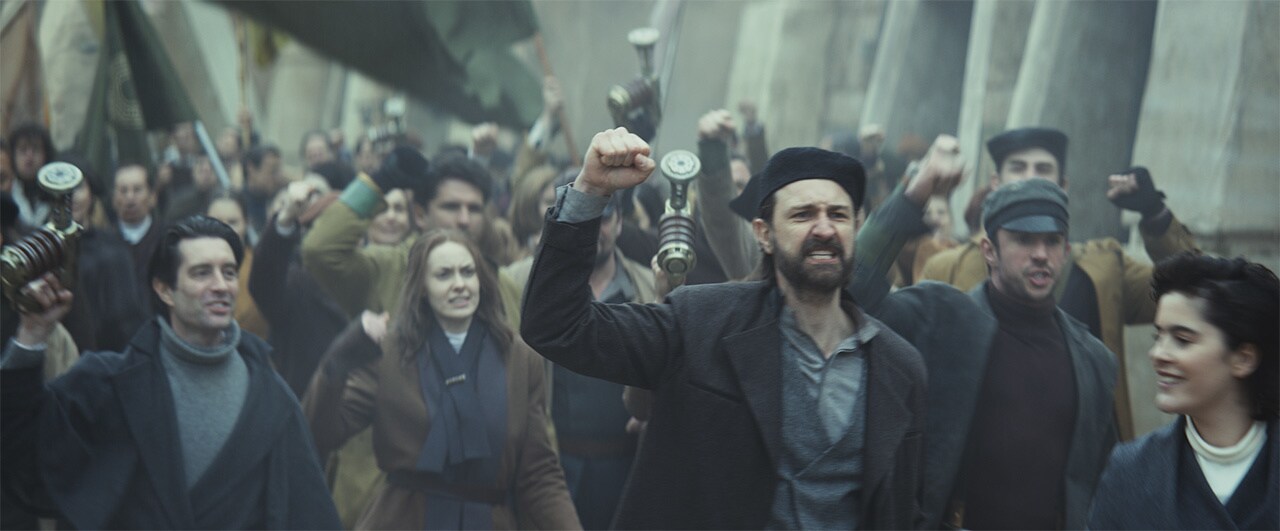
Above: "We are the Ghor, the galaxy is watching" chant in Episode 8, “Who Are You?“
The sequence included spoken dialogue and screams as well as chanting and singing in Ghor. Much of the crowd noise was captured on the set from production tracks. “We had a wonderful production sound mixer, Danny Hambrook, and he recorded with many, many different microphones,” notes Pfeiffer. “So there was a wonderful bed of energy and intensity, and we could layer it within Dolby Atmos as a bed for all the close up things we added.”
The voice of the Ghor
For the loop group — a collective of voice actors who record sounds and lines of dialogue in the background of scenes, — “the great challenge was to record in a fictional language,” notes Pfeiffer. As the Ghor language was based on French phonetics, members of the loop group were mostly comprised of native or proficient French speakers. “We got about 100 lines written by Tony Gilroy with exact stage directions on where to use them and we practiced them,” says Pfeiffer. “We had sound samples and made sure the pronunciation was right. We then recorded it in talking and screaming and chanting and singing and panic cries and yells, so you could bring emotion to the scene, or anger in the town hall. ”
Members of the loop group recorded remotely in individual studios around the world, which provided some challenges for the sound team while simultaneously giving them greater control of the final output. “For something like Ghor, it’s hard to sync up the chanting and the singing when everybody’s sort of in their own world,” says Pfeiffer. “But I had full control over every single line, every single take, so it allows for great freedom. I would say half of the human element you hear in the Ghorman massacre was loop group.”
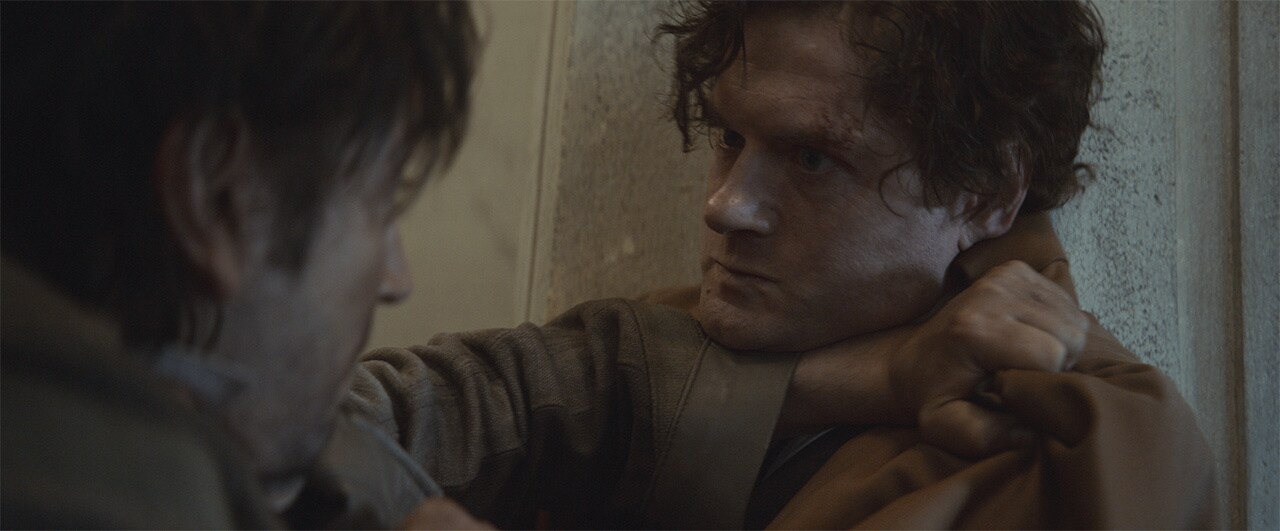
Above: Syril and Cassian face off in Episode 8, “Who Are You?”
Foley and ambient sounds were used more when the sound designers wanted more realism. “So you’ll play the background up with crowds or tones to immerse yourself more” says Pfeiffer. “For large crowd scenes on Ghorman plaza you’ll have the closeups of people handling things like the helmets or the punches between Syril and Cassian. It gives it realism that draws you right into that moment.”
While Roberts was working on scoring episodes he was in contact with David Acord and his sound engineers to make sure the musical “doom bends” didn’t clash with other sounds from the sequence such as air horn blasts or the cacophony of the crowd. Through the collaborative process, Andor’s creative team made decisions about what scenes would benefit more from the absence of a musical score, such as the moment after an Imperial riot trooper shoots a Ghorman citizen. “We wanted everyone feeling nauseous leading up to it,” says Roberts, “but then ironically leaving music out during the action sustains the kind of ill feeling because you no longer have music cradling you in a traditional action sense.”
The lay of the land
Another key element in designing the sounds for the Ghorman massacre was helping the audience orient themselves. “Every location on the plaza should have its own unique sound, so you can identify with whoever you're with in the fast cutting back and forth,” says Pfeiffer. “Are you with the Imperials? Are you with the big mass in the center? Are you with the people fleeing? Are you with the people trapped and being killed? Are you in the underpass where Wilmon is trying to talk to Cassian? It helps you identify where you are within the story, in a moment that could be quite chaotic if you didn't know where you are.”
“No matter what you're focusing on, whether it's music or effects, we always hear the dialogue,” adds Acord. “Tony likes to have the dialogue a little crowded. He likes the viewers to kind of lean in. It creates a sense of you becoming a participant.”
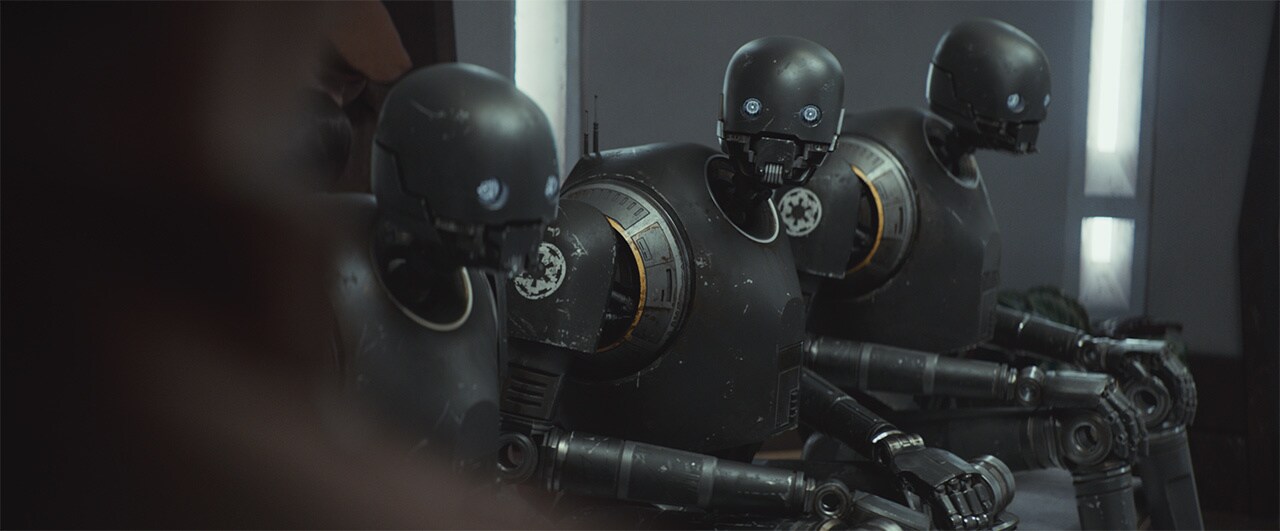
Above: Syril enters a room full of deadly KX droids in Episode 8, “Who Are You?”
Roberts’ score included percussionists dropping chains on large oil drums during scenes involving the KX droids in action to add to the horror element during the massacre. For an earlier scene where Syril enters a room of multiple KX droids sitting in a small room, Acord and his team wanted to play up the fear of him being in such close proximity to droids that could kill him in an instant. “The sound in that moment is a low drone in the room,” says Acord, “as if that's sort of the power sound in that room, like these things are charging. But it's so dead quiet except for that drone and Syril's breathing, which puts us in Syril’s space, where his breathing is just a little bit louder than it would normally be. So we are drawn into him, and we feel like we are him at that moment. It's a totally eerie scene.”
Roberts worked on the score for around ten months, leading an orchestra that included 40 string musicians, 20 brass players, ten choir members, four percussionists, four woodwind musicians, and the cimbalom and dulcimer soloists. The score for each three-episode story arc of Season 2 was recorded in London over the course of a week. “To get to do that four times is unheard of and such a gift,” says Roberts. From there, Acord took the score, sound effects, dialogue, and ADR (automated dialogue replacement) and worked with his team for several more weeks until everyone, including Tony Gilroy and executive producer Sanne Wohlenberg, were happy with the final result.
In a chilling end to our time on Ghorman, the credits of “Who Are You?” features a choir of eight women and two soloists, one who sang the Ghorman aria and the other who sang an arrangement of the Ghor national anthem. “We realized we had to have a linguist work with the choir because they need to be singing in Ghor,” says Roberts. “The day of the recording session, they worked with the singers making sure they could sing it. We had sent them demos, but then to perform and sing it in another language is a whole other thing. By the end of the day, they were fluent in at least that portion of the language. It was a neat day of recording.”
The choir can also be heard in the main title sequence of Episode 8’s intro, including the choir softly humming the main Andor theme while the soprano soloist sings the Ghor national anthem on top of dissonant strings. “I wanted to try and do something that would set up the whole episode,” says Roberts. “It was kind of a musical experiment. I don’t know if these three totally disparate elements would work together, but it worked.”
For everyone involved in Andor’s second season, staying true to the history of Star Wars while creating something new was the goal. “There’s a big wonderful [Star Wars] sound library and where it is appropriate you dip into it,” says Pfeiffer. “But you also want to embellish on it to keep it fresh. Star Wars is a fairly gritty type of sound and you want to lean on it even though you don’t use the exact sound files. You want to create your own and play within that universe and leave your own mark on it if you go to a new planet that hasn’t been explored.”

